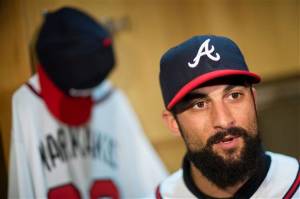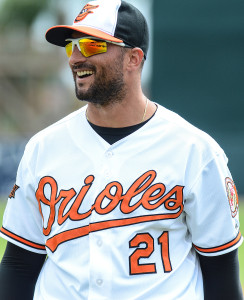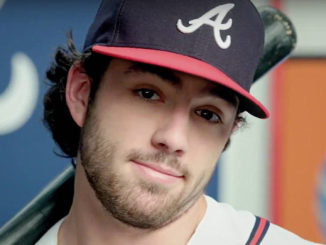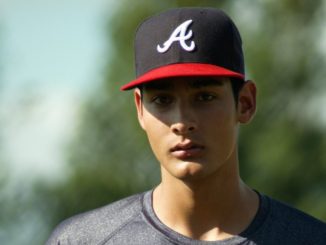
Last month the Atlanta Braves traded talented young right fielder Jason Heyward to the St. Louis Cardinals, creating an opening in the outfield. I wrote at the time that the deal was a sound business move, even if it was one that saddened me a little. That trade led to speculation about who would play right field for Atlanta in 2015. Would Justin Upton move over to RF? Would a piece be picked up in a trade? Would a big-name free agent be signed? Those questions seemed to be answered on December 3rd when the Braves signed free agent outfielder and former Baltimore Oriole Nick Markakis.
Initially, I was a little cool to this signing. I will admit that some of it was likely due to Markakis being the “replacement” for one of my favorite players. But I was also cool to it because there are at least some signs of decline that appeared, and there is a bulging disc in his neck that has been and still could be problematic. Markakis will have surgery (a single-level fusion) to repair the disc on December 17th, and will be done by surgeons selected by the Braves. I also had concerns about the apparent dichotomy between his Gold Glove awards and his lack of range, according to certain metrics.
After having had some time to reflect on the Nick Markakis move, I am a little more upbeat about it than I originally was. Nick Markakis should not be viewed as a replacement for or compared to Jason Heyward for any year beyond 2015. Heyward was very unlikely to be the Atlanta Braves’ RF after 2015, instead likely choosing to become a free agent. Heyward was traded to obtain value for him before he left; he was NOT traded so that the Braves could sign Markakis. Once that distinction is understood, then the Nick Markakis signing can be more properly graded (although, it is still but a piece of an as yet unfinished puzzle).
[sc:InContentResponsive ]
The Offense
Nick Markakis owns a career slash line of .290/.358/.435. He has traditionally been difficult to strike out, owning a career K-rate of 13.0%, although it has been at 11.0% since since 2011. He walks regularly, with a career 9.3% career BB-rate. His BB/K rate is very steady as a result. Markakis has a good understanding of the strike zone, and he tends to control it favorably. These are skills that are difficult to teach, as they are more dependent on an individual’s own eyesight and reaction times. As a result, Markakis isn’t likely to see a dramatic fall off in his ability to get on base.
He also makes contact at a very high rate, hovering around 90% contact rate since 2011. However, making “a lot of contact” should not be mistaken for making “good contact”. Markakis has lost any semblance of power, showing a loss of almost 20 feet on his average fly ball distance since 2012 (and 30 feet since 2009). The loss of power could be a result of lingering injuries (thumb and wrist issues, hernia surgery, and the lingering neck issue), a result of an aging player, a difference in approach at the plate, or a combination of all three.
The loss of distance on the fly balls is particularly concerning when you consider that Markakis played in a park that seemed to cater to LHB. Here is a plot from Fangraphs.com of all of Markakis’ home runs at home for the last 3 years:

Camden Yards has a right field area that is shorter than that at Turner Field. Many HRs and doubles at Camden will simply be outs in Turner Field. Turner Field does have a slightly more cavernous Left-Center power alley that could yield more doubles, but whether that is enough to offset the shorter LF fence is still to be determined.

One area where Markakis will be an upgrade will be against LHP. While he does have a slight platoon split, Markakis is not completely lost against southpaws. He holds a career .288/.344/.398 line against LHP, with a wRC+ of 100 (league average). By comparison, the guy he is (not) replacing–Heyward–has a career .221/.301/.349 line against lefties, with a wRC+ of 81 (19% below league average).
While I said that Heyward and Markakis should not be compared because they were not moved for one another, the reality is that the Braves have essentially replaced Jason Heyward’s bat in the lineup with…Jason Heyward’s bat. Markakis strikes out a little less and walks a little less. He makes more contact and hits LHP much better. Basically, the Braves have decided to forgo the better production against RHP for a more consistent approach overall. While Markakis doesn’t hit righties as well as Heyward (Heyward 133 wRC+ vs RHP, Markakis 118 wRC+ vs RHP), he is also not non-existent against LHP, either. Simply being league average against LHP as he has been will offset any loss of production Markakis has against RHP, making the lineup a little more balanced.
[sc:InContentResponsive ]
The Defense
This is where the real debate lies when evaluating the Nick Markakis signing. Markakis is routinely graded by scouts and managers and fans as a very good defender. He is also routinely rated as below average by most advanced defensive metrics. Does this mean that neither is to be trusted?
First, some background. Ultimately, one has to decide which they trust more: eyes or stats. When it comes to defensive stats, I tend to trust defensive stats more after 2002, and even more so after 2010. The reasoning behind that is due to how some of the more advanced defensive stats are derived. Many people who are not sabermetrically inclined seem to think that defensive stats are just a series of calculations, and that there is no comparison against other players or no ‘eye test’ involved, and that just isn’t true.
Since 2010 or so, Baseball Info Solutions (and others) has recorded every play made by every player at every position in every game of every season. These plays are taken from video recordings and plotted on a field diagram that has been sectioned off in several (sometimes 14, sometimes 26) zones of responsibility, some of which overlap. By tracking this data and plotting where the play was made, the distance covered, the reaction times, and all the data that is available now that wasn’t available even 10 years ago, we can make a pretty reasonable and accurate determination as to what plays the average player at that position can make. It isn’t perfect, but because every single play in a season is recorded on video and tracked in the data, it gives us a much more reliable sample than say, the eyes of a manager who may have only seen 16 shortstops make 95 plays on the season. That’s one of the reasons that baseball nerds like me are really looking forward to the StatCast release next season.
I could write a lengthy couple of paragraphs about Markakis’ defense and whether he is truly a great defender, or merely a defender who is great at making catches on the balls he can get to. Instead, I will quote from a piece by Sam Miller and Nick Shlain from Baseball Prospectus:
Here’s a lot of what we know about Markakis’ defense. Some of these bulletpoints are worth more than others.
*He won a Gold Glove, this year.
*He was a Gold Glove finalist in 2013.
*He won a Gold Glove in 2011, too.
*He was not a finalist in 2012.
*Fielding Bible voters placed him ninth at RF this year.
*Fielding Bible voters did not place him on a single ballot in 2013. (Twenty right-fielders were named.)
*Fielding Bible voters placed him 14th in 2012, seventh in 2011, 12th in 2010, ninth in 2009, and second in 2008.
*In the Fans Scouting Report, he ranks third among all right-fielders.
*He is, in the Fans Scouting, average or better in every facet.
*He has been, in all six years of Fans Scouting Report voting, a plus right-fielder
*By Inside Edge’s metrics—which assign a degree of difficulty to each play—he made
- more “remote” plays than any other right-fielder in 2014
- the second-most unlikely plays of any RF (out of 16 qualifiers)
- the seventh-most “even” plays
- the second-most “likely” plays*
- and every single routine play, one of only three RFs to do that
*DRS has him -22 runs over the past five years, and +0 in 2014
*UZR has him -20, but +6 in 2014
*The issues are with range; UZR’s assessment of his range over the past five years has been very consistent, until it wasn’t: -8.2, -9.2, -8.9, -11.5, -1.6
*FRAA has him -5, and +2 in 2014
*At least one metric has rated him positively in three of the past five seasons
*Of the 15 numbers put on him by the three metrics since 2010, 10 were negative
*The Braves, with better metrics than we have, paid him as though he’s a good defender.
*The Orioles, with better information than the Braves, did not.
They pretty much summed up everything we know about his defense. And as Miller and Shlain mentioned in another paragraph in their piece, the competition for the AL Gold Glove award was very week this year, for multiple reasons. The RF finalists this year were Kole Calhoun (Angels), Kevin Kiermaier (Rays), and Nick Markakis. Kiermaier started only 57 games (and played only 68) at right field. When making allowances for injuries or multi-position usage, there were essentially six full-time RF in the AL this season: Torii Hunter, Jose Bautista, Kole Calhoun, Nori Aoki, Alex Rios, and himself.
Markakis likely lies somewhere between what the fans/scouts/managers and the metrics say. He is probably very good at making the plays he can get to, but likely has a fairly limited range. If he can be a roughly league average defender, then the overall Markakis value will remain high. But if he plays more towards the type of player the metrics suggest he is, then the overall value tends to fall. I think fans who are accustomed to seeing Jason Heyward play RF will be disappointed, but that isn’t fair to Markakis. Heyward is one of the best in the game, and Markakis just may be good enough to not hurt us.
Other
Markakis will not bring any value with his baserunning skills. While he has may be average speed at best, he seems to be a fairly smart baserunner who also won’t run into outs. His lack of speed is sometimes noted as a deficiency at the top of the lineup, where he is expected to hit, but I don’t see it as that big of a deal. If Markakis were to lead off for Atlanta, three of the next four batters (as of now) would be Freddie Freeman, Justin Upton, and Evan Gattis. All of them are solid extra-base hitters capable of driving Markakis in from first. I would be more concerned about his speed lower in the order, with the proliferation of singles hitters unable to drive him in without stringing together three hits.
While I tend to stick with only those things that can be measured by actual on-field performance, the Braves apparently gave some value to Markakis’ reputation as a “gritty” veteran who ‘grinds out’ plate appearances. Markakis was also apparently very well respected in the clubhous and out by his teammates. Seven-year teammate Adam Jones had this to say about Markakis in an interview with Dan Connolly of The Baltimore Sun:
“I thought [Markakis re-signing] was going to happen. When you think of the Orioles, you think of Nick Markakis in my eyes. He was just that gritty guy. If you want to break it down into business terms, that’s what happened with this situation. It was business. And, OK, this is how business is. … The reason why Markakis is [special] is, you know the Oriole Way? Well he is the definition of the Oriole Way. He straps it on. He plays every day, plays hard, runs hard down the line. He dives, he’s gritty. Got eye black on. Plays the game hard, plays the game with respect. That’s the Oriole Way.”
I really don’t know how, or even if, you can measure the effect of eye black on a game. But for those who believe having a respected veteran presence in the clubhouse can be a determining factor, the Markakis signing should be good news. That, by the way, isn’t a knock against Markakis. By all accounts, he was a good and respected player behind the scenes in Baltimore, and for a team that features many young players like Atlanta does, that could be a welcome addition. During the run of 14 division titles (and after), the Braves always seemed to have certain players who would act as a check against the youthful exuberance of players recently promoted: Tom Glavine, Greg Maddux, John Smoltz, Chipper Jones, Brian McCann, Martin Prado, Tim Hudson, David Ross, Eric Hinske. Even Dan Uggla, despite his falling off a cliff with the bat the last two years, was said to be a very focusing voice in the clubhouse…at least until he was benched and stopped caring around the All-Star break last season.
 Having a respected veteran in the clubhouse is one of those things that many in the advanced metrics community scoff at, with the reasoning being that, if it had an effect, then it should be able to be measured, and it should be able to be repeated. While I tend to agree with that assessment, I will note that I also think it is one of those things that can’t hurt…as long as the player’s performance isn’t hurting the team. If my options are a player with Nick Markakis’ skill set and abilities but is a relatively young player, and Nick Markakis, then it wouldn’t hurt to take the veteran player for clubhouse harmony.
Having a respected veteran in the clubhouse is one of those things that many in the advanced metrics community scoff at, with the reasoning being that, if it had an effect, then it should be able to be measured, and it should be able to be repeated. While I tend to agree with that assessment, I will note that I also think it is one of those things that can’t hurt…as long as the player’s performance isn’t hurting the team. If my options are a player with Nick Markakis’ skill set and abilities but is a relatively young player, and Nick Markakis, then it wouldn’t hurt to take the veteran player for clubhouse harmony.
The Contract
The Braves and Nick Markakis agreed to a 4-year/$44M contract. For a player with a career OPS of .793 and two Gold Gloves, the average annual value (AAV) seems good. If we assume that a single Win (Above Replacement) is worth about $7M, Markakis simply needs to average about 1.6 WAR per season over the life of the contract to be worth the money. I fully expect Markakis to be at least league average, and possibly slightly better, in ’15 and ’16. That means that he just needs to be worth slightly more than 2 Wins over the final two seasons to be at least worth the contract value.
I like the AAV; I think it is very reasonable for Markakis. I do have a little concern for the term, given that Markakis is entering traditional decline years for a player. That is offset slightly by the his offensive skill set described above, which tends to age well. The salary is not so onerous that it becomes an albatross of a contract that is impossible to move or dump (cough B.J. Upton cough).
The Verdict
For me, this seems like a bit of a “rush” signing. That isn’t necessarily bad, and the Braves were going to have to sign someone (unless they expected a return piece in a potential trade) anyway. The options available for a corner OF bat this off-season are limited, and aren’t overly impressive. Still, Markakis basically replaces Heyward at the plate with a potentially more consistent option. Of course, Markakis is also aging and showing some signs of decline.
Nick Markakis to me seems like a very good complementary piece. I’m just not sure yet what or who he is supposed to complement. But having had time to reflect, the best way I can describe it, at least for now, is an okay signing that doesn’t make much sense, given the context of what the Braves’ stated goals are.




Leave a Reply